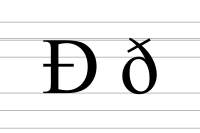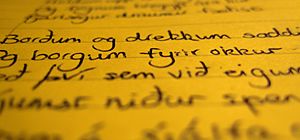Eth facts for kids
Quick facts for kids Ð |
|
|---|---|
| Ð ð | |
 |
|
| Usage | |
| Writing system | Latin script |
| Type | Alphabetic and Logographic |
| Language of origin | Old English language Old Norse language |
| Phonetic usage | [ð] [θ] [[[Error using : IPA symbol "ð̠" not found in list|ð̠]]] /ˈɛð/ |
| Unicode value | U+00D0, U+00F0 |
| History | |
| Development | |
| Time period | ~800 to present |
| Descendants | Đđ |
| Sisters | None |
| Transliteration equivalents | d |
| Other | |
| Other letters commonly used with | th, dh |
Eth (pronounced like "eth"), written as Ð (uppercase) and ð (lowercase), is a special letter. It was used a lot in old languages like Old English and Old Norse. Today, you can still find it in languages like Icelandic and Faroese.
In the past, people in Scandinavia also used Eth during the Middle Ages. However, it was later replaced by the letters "dh" and then just "d". Sometimes, when old texts are copied into modern English, Eth is simply written as "d". The small letter ð is also used in the International Phonetic Alphabet to show a specific "th" sound, like the one in the word "this."
Contents
Eth in Old English
In Old English, the letter ð (called ðæt) was used along with another letter called þ (thorn). Both letters made a "th" sound, like in the modern English words "thin" or "this." They were used interchangeably, meaning writers could pick either one.
Unlike thorn, which came from ancient symbols called runic letters, ð came from a modified Roman letter. It started appearing in English writing around the early 700s. Some historians believe it came from Irish writing.
Later, during the time of King Alfred, the letter þ became much more popular than ð. By the Middle English period, þ had almost completely replaced ð. Eventually, both letters disappeared from English. This happened partly because of the rise of the printing press, which preferred simpler letters. The "th" sound then started to be written using the two letters "th" together.
Eth in Icelandic
In Icelandic, the letter ð is called "eð." It makes a sound similar to the "th" in "this" or "thin." Usually, the letter Þ is used at the beginning of words for this sound. But ð is used in the middle or at the end of words. In the Icelandic alphabet, ð comes right after the letter "d."
Eth in Faroese
In the Faroese language, the letter ð is a bit different. It doesn't always make a specific sound on its own. It's mostly there because of how the words developed over time. However, it often helps to show certain gliding sounds, like the "y" in "yes" or the "w" in "we." Sometimes, if ð appears before the letter "r," it can even sound like a "g." In the Faroese alphabet, ð also follows the letter "d."
Eth in Other Languages
- In some older versions of Nynorsk (a form of Norwegian), ð was used but was always silent. It was included to show how words were originally spelled.
- Some people have used ð in written Welsh to represent a "th" sound, which is usually written as "dd" in Welsh.
- In some ways of writing the Khmer language (spoken in Cambodia), ð is used to represent a specific Khmer letter.
Eth and Computers
If you're using a computer in Faroese or Icelandic, you'll find a special key just for the letter ð on the keyboard.
On Microsoft Windows computers, you can type ð by holding down the Alt key and typing specific numbers. For example, Alt + 0240 makes a lowercase ð. On Linux computers, you can often use a "compose key" to type it.
Modern Uses of Eth
- Sometimes, the lowercase letter ð is used in advanced mathematics and engineering books. It acts as a special symbol for a type of partial derivative, which is a concept used to describe how things change.
- The uppercase letter Ð is used as the currency symbol for Dogecoin, a type of digital money.
See also



